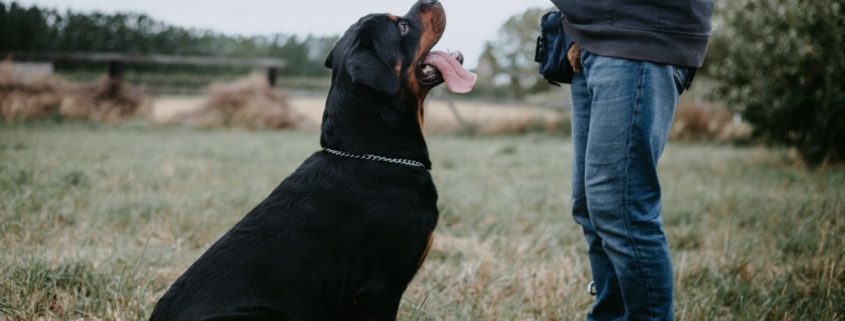Ask Crystal: Dog Communication 101
Welcome to “Ask Crystal,” where you can ask your pet behavior questions! You can submit your question for Crystal at the bottom of the page!

Dear Crystal,
I need help with training my dog to listen to me. She listens sometimes but other times she just does whatever she wants to do. How can I make my dog more obedient?
Sincerely,
Selective Hearing Puppy
Dear Selective,
There are a lot of reasons why a dog may display selective hearing and it depends on the situation. One of the more frustrating ideas that a majority of dog owners still hold on to is the idea that a dog listens to cues out of the desire to please us. There are a lot of amazing things about dogs but let’s stop doing them this disservice. It only leads to frustration on both parties’ part. Do you go to work out of the kindness of your heart? I doubt that behavior would be maintained for very long without a paycheck. Every other animal like dolphins, elephants and lions people accept that food is needed to train, why is there such a stigma to using food to train dogs? The most important principle to understand in dog training is that dogs do the behaviors that work to get the reinforcement they want. When teaching your dog a new behavior, your job as the trainer is to figure out how to motivate the dog to want to do the behavior and to set up the situation so that they are able to learn.
Food is the most immediate and easy to use reinforcement for the majority of dogs. There are different values to different types of food and every dog has different preferences. When training a new behavior or in a new context, you want to use the highest value of treat that works to motivate your dog. In general, high value treats are meat based, smelly, easy to eat quickly and break up into pea sized pieces. Dry treats like biscuits don’t hold much value in distracting situations. If you are training your dog and they seem distracted, the first thing to try is a higher value treat. If a dog knows a behavior very well, which means they respond to the cue 80% of the time, you can start using lesser value treats. There are some behaviors that are inherently enjoyable to the dog and you can often use lesser value treats for those activities as well.
 Communication is another huge stumbling block for most owners. Dogs don’t speak English. I swear in every class someone tries to convince me how their dog knows so many words and they are convinced the dog understands English. The truth is that dogs are very good at learning associations between things. The dog gets crazy excited when you pick up the leash. Soon the dog goes crazy when you put on your shoes. Dogs are very good at picking up on patterns and creating associations. Somehow your dog learned an association between the word and the behavior. I almost always start training with lures or my body and then create an association with word once the dog knows the hand signal. If you have asked your dog to do a behavior 5 times in a row and they don’t respond, please stop. If he doesn’t listen the first time you are teaching him to ignore you. Most likely what is happening is the dog doesn’t know the word well enough yet or you haven’t worked with distractions enough yet. Humans also talk to their dogs way too much during training. Make your communication meaningful, otherwise it is all just white noise and the dog doesn’t know what is meaningful. Dogs do however understand tone of voice. Many people that are convinced that their dog understands the word “no” but what the dog is really responding to is the growly tone of voice. The growly tone inhibits behavior. We use our tone of voice a lot in training to help motivate the dog to do different behaviors.
Communication is another huge stumbling block for most owners. Dogs don’t speak English. I swear in every class someone tries to convince me how their dog knows so many words and they are convinced the dog understands English. The truth is that dogs are very good at learning associations between things. The dog gets crazy excited when you pick up the leash. Soon the dog goes crazy when you put on your shoes. Dogs are very good at picking up on patterns and creating associations. Somehow your dog learned an association between the word and the behavior. I almost always start training with lures or my body and then create an association with word once the dog knows the hand signal. If you have asked your dog to do a behavior 5 times in a row and they don’t respond, please stop. If he doesn’t listen the first time you are teaching him to ignore you. Most likely what is happening is the dog doesn’t know the word well enough yet or you haven’t worked with distractions enough yet. Humans also talk to their dogs way too much during training. Make your communication meaningful, otherwise it is all just white noise and the dog doesn’t know what is meaningful. Dogs do however understand tone of voice. Many people that are convinced that their dog understands the word “no” but what the dog is really responding to is the growly tone of voice. The growly tone inhibits behavior. We use our tone of voice a lot in training to help motivate the dog to do different behaviors.
Environment is key during the initial training phases. You must start training inside the house where the distractions are manageable, and where the dog is more comfortable. The dog park is not the place to start training your dog. Once they know the behavior very well, then it can be a great place to work on distractions. I always tell my group class students that class is not a great place to teach our dogs a new behavior, most of the work needs to happen inside the house. Once the dog is responding consistently inside the house, start working in the backyard, then the front yard, the driveway, the street in front of your house, walks, and lastly public places with high levels of distractions. Remember your high value treats when working in high distraction areas.
Repetition is key in dog training. If you think your dog knows the behavior, keep practicing. You can always ask for faster and cleaner responses to refine the behavior. The next step is teaching your dog to generalize the behavior to a variety of locations. I often see people in a store yelling “sit” at their dog and when the dog doesn’t listen, they swear it is just being stubborn. The reality is that the dog doesn’t understand that the behavior can occur in this location because you never practice it anywhere except at home. Or the dog is too distracted by the environment and you are asking too much from them too soon or your reinforcement doesn’t match the scenario.
 Another mistake most people make is giving the dog everything for free. Why should your dog listen if everything they want comes whenever they want it? One of the most useful concepts I have found for getting a dog to consistently respond is life rewards. Life rewards are all of the things that your dog wants and needs in life. I suggest that you make a list of everything that your dog loves. The list could include being fed, going outside, having the ball thrown, getting the leash put on, etc. An example is when the dog stands by the door to be let out, before you let the dog out you ask them to sit. If they don’t sit the door doesn’t open. It can take a few times until the dog gets the idea. You may need to hold a lure to get the dog into the position and then when they do the behavior give them the life reward rather than the food. This is a great way to wean the dog off of needing a food reinforcement for everything. I have found that offering a wide variety of reinforcements results in a dog that is more willing to listen because they have no idea what the reinforcement will be, but they know you pay well. You remove the contingency of a treat needing to be in your hand to receive a reinforcement. My dogs always wanted to chase the squirrels so I would have them sit and wait at the open door and the reward was getting to chase the squirrel. Really fun activities can be much more reinforcing than simple food rewards.
Another mistake most people make is giving the dog everything for free. Why should your dog listen if everything they want comes whenever they want it? One of the most useful concepts I have found for getting a dog to consistently respond is life rewards. Life rewards are all of the things that your dog wants and needs in life. I suggest that you make a list of everything that your dog loves. The list could include being fed, going outside, having the ball thrown, getting the leash put on, etc. An example is when the dog stands by the door to be let out, before you let the dog out you ask them to sit. If they don’t sit the door doesn’t open. It can take a few times until the dog gets the idea. You may need to hold a lure to get the dog into the position and then when they do the behavior give them the life reward rather than the food. This is a great way to wean the dog off of needing a food reinforcement for everything. I have found that offering a wide variety of reinforcements results in a dog that is more willing to listen because they have no idea what the reinforcement will be, but they know you pay well. You remove the contingency of a treat needing to be in your hand to receive a reinforcement. My dogs always wanted to chase the squirrels so I would have them sit and wait at the open door and the reward was getting to chase the squirrel. Really fun activities can be much more reinforcing than simple food rewards.
There are a lot of reasons why dogs choose not to listen to us. We should always be considering what the dog’s motivation for performing the behavior is and if we are meeting that need. Many times, the dog has not had enough practice to be able to perform under the conditions we are asking them to. To give you an idea, it takes 3000 repetitions to classically condition a response. It just takes a lot more work and practice than you have probably put it in yet. I have no doubt you will get better responses with some more practice!
Until next time,
Crystal







